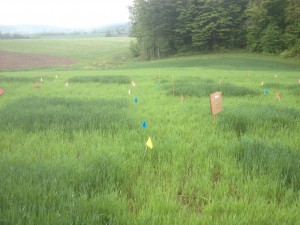Over the course of my internship thus far I have been to several field days covering a wide range of subjects. Field days are usually put on by a Cornell program located here on campus or through the Cornell extension service. The purpose of field days is to share information regarding different research that is currently going on through Cornell. Generally the audience consists of farmers, extension agents, consulting firms, and other Cornell researchers. Presentations are given about each of the projects at the given location usually in addition to a tour of the facilities.
One of the first field days I attended was the small grain grower’s field day. This field day was almost entirely focused around the recently passed farm brewer’s bill. Due to the lack of barley and other small grain crops being grown for malting, these researchers were quite busy this year testing a wide range of  varieties to determine which grow best in New York’s climate. In addition to being able to grow well, they must also be of high malting quality. This narrows the options down quite a bit since the quality needs to be top notch in order for the crop to be used for malting. Growers are extremely interested in the results of this research as many of them are likely going to be growing crops that will be used for malting as a result of the farm brewer’s bill.
varieties to determine which grow best in New York’s climate. In addition to being able to grow well, they must also be of high malting quality. This narrows the options down quite a bit since the quality needs to be top notch in order for the crop to be used for malting. Growers are extremely interested in the results of this research as many of them are likely going to be growing crops that will be used for malting as a result of the farm brewer’s bill.
The next field day I attended was the forage yield monitor field day. This field  day was hosted by Gary Swede Farms, Agrinetix, and the Cornell Nutrient Management Spear Program (NMSP). This was mainly put on to provide information about forage yield monitors such as the importance of forage yield monitors, how they work, calibrating the monitors, and constructing yield maps from the collected data. The NMSP’s project looking at the accuracy of the yield monitors was also presented showing some preliminary results.
day was hosted by Gary Swede Farms, Agrinetix, and the Cornell Nutrient Management Spear Program (NMSP). This was mainly put on to provide information about forage yield monitors such as the importance of forage yield monitors, how they work, calibrating the monitors, and constructing yield maps from the collected data. The NMSP’s project looking at the accuracy of the yield monitors was also presented showing some preliminary results.
The most recent field day I attended was the Aurora Farm Field Day. It took place at the Aurora research farm, where there are numerous research projects including several which belong to the Nutrient Management Spear Program. One of the projects presented was looking at planting date and planting depth of corn and soybeans. Several other studies were variety testing of corn and other forage crops. One study that I found to be of particular interest was a fairly new piece of equipment which is used as an inter crop seeder. The purpose of the machine is to go over corn when it is about waist high and plant the cover crop which is to  follow the corn once it is harvested. This helps the cover crop by having it establish earlier to increase the benefits it provides. Another presentation that covered a fairly new piece of equipment was one by the NMSP. The piece of equipment was a small scale manure injector that just arrived from Penn state. This will be used in the future for a study comparing different injection rates and application methods. Unfortunately, this presentation had to be done indoors due to some unexpected afternoon showers!
follow the corn once it is harvested. This helps the cover crop by having it establish earlier to increase the benefits it provides. Another presentation that covered a fairly new piece of equipment was one by the NMSP. The piece of equipment was a small scale manure injector that just arrived from Penn state. This will be used in the future for a study comparing different injection rates and application methods. Unfortunately, this presentation had to be done indoors due to some unexpected afternoon showers!









